If you’re planning on growing your own rhubarb, you want to make sure that you are aware of what plants make good companions for them. Here are 24 great companion plants for rhubarb.
Growing a herb or vegetable garden may seem a little tricky if you are new and need some ideas.
Well, keep reading if you want tips on growing your garden rhubarb and want to know some good and bad companion plants for it.
But first, what is a companion plant? And what is a rhubarb?
A good companion plant, say rhubarb, is another crop that can grow comfortably with rhubarb, help with its growth and encourage better harvest.
It could also be a plant that rhubarb can provide benefits.
The two may help each other by repelling harmful pests, inviting or attracting useful insects, replenishing soil nutrients, serving as ground cover, and providing shade.
A plant may be considered a suitable companion for another if they can grow together without one thriving while the other is dying, have similar growth needs, and do not compete with each other for space and nutrients.
Companion planting is a method of cultivating several crops by planting them with or beside some other crops that are beneficial to them or at the very least comfortable growing in the same area.
Rhubarb is a herbaceous perennial plant that grows from short, thick rhizomes. It possesses small white or rose-red flowers and large, triangle-shaped but inedible leaves. The leaves contain acids and other compounds that make them unfit to be eaten.
The edible parts of rhubarb plants are the fleshy, usually red stalks. They may be eaten raw with their crisp, crunchy texture similar to celery and their strong tart taste. Sometimes they are cooked with sugar and used to make many desserts.
Rhubarb contains several nutrients, including carbohydrates, calcium, choline, fat, iron, magnesium, manganese, protein, phosphorus, potassium, sodium, zinc, and vitamins B1, B2, B3, B5, B6, B9, C, E, and K.
Now that we have defined the keywords, we will learn about some other plants you can grow in your garden to aid the growth and development of your vegetable.
We will also learn of some plants that are poorly suited for planting beside them.
Listed and explained below are twenty-four (24) good and eight (8) bad companion plants for rhubarb. The article includes brief introductions of the crops and why they are suitable, or not, for planting with rhubarb.
Here are the best companion plants for rhubarb:
Table of Contents
24 Great Companion Plants for Rhubarb
1. Asparagus
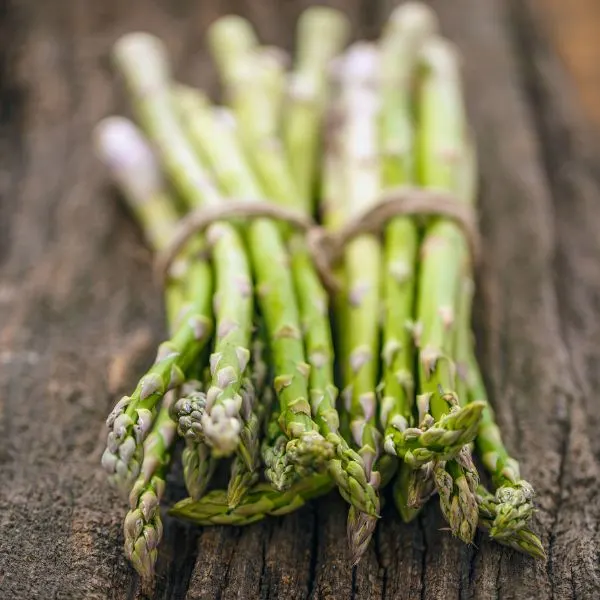
Rhubarb tends to grow well with many vegetables, asparagus included.
They both like to grow in fertile, moisture-retentive but well-draining soil, with full exposure to sunlight and a regular amount of water that does not leave their roots soggy.
Known by some other names like green asparagus and sparrow grass, asparagus is a perennial flowering plant. It is aromatic and used as a spring vegetable, with its young green or white shoots cooked and eaten.
This plant has deep roots and should most preferably be paired with other plants that have shallow roots, like rhubarb.
Asparagus is a very good companion plant for rhubarb, as they are very comfortable being grown side by side.
The deep roots are able to break up clay or soggy soil that is packed together. They help loosen up the soil and absorb excess water in it.
This reduces the chance of root rot and some of the stress on nearby rhubarb plants.
Companion planting involving asparagus and rhubarb is an excellent idea because they both have similar care needs.
Asparagus helps reduce the stress on rhubarbs.
It is also common to see them planted alongside strawberries.
2. Beans

These are seeds of several genera of flowering plants that belong to the botanical family Fabaceae.
Bean seeds are then boiled, fried, baked, or cooked by some other method and used as vegetables for humans or animals to eat.
Beans are good companion plants for rhubarb because they are legumes, plants with nodules in their roots that help fix nitrogen in the soil.
They improve the quality of the yield of other plants because they supply nutrients to the soil.
This is especially true of rhubarb because the plant requires a good amount of nitrogen to grow properly.
By planting pole beans or bush beans near it, your rhubarb plant can get this key nutrient that it needs.
Beans can also help in your garden by providing good ground cover.
By doing so, they help prevent water loss resulting from evaporation.
They also prevent and reduce the growth of weeds that will otherwise spring forth in that area.
Rhubarb and beans have a symbiotic relationship, as rhubarb is a known insect repellent beneficial for its ability to repel aphids.
The leaves of rhubarb plants contain oxalic acid, the compound that makes them unfit for consumption.
The implication of this is that when aphids, which eat almost anything, become attracted to your bean plant, they will be repelled by the acid contained in the rhubarb around them.
Thus the aphid infestation of beans is reduced significantly.
3. Beets

Beets are flowering plants in the amaranth family grown for their edible taproots, called beetroot, and leaves, called beet greens.
This species goes by several other names, including dinner beet, garden beet, red beet, and table beet.
Growing rhubarbs and beets together works as both of these plants fare well in similar soil: rich, consistently moist but well-draining.
They both do not like very dry soil or soggy soil because these conditions harm them.
Also, like beans, beets have a symbiotic relationship with rhubarbs: both parties benefit from the arrangement.
Beets are susceptible to attacks from various insect pests, including aphids, beetles, cutworms, leafhoppers, and webworms.
The presence of rhubarb beside your beet plant can lead to the discouragement of some of these pests.
This reduces pest infestation in your garden, helping to improve the yield of your beet and rhubarb plants.
Beets can keep rhubarb from going too woody, keeping the plant’s flavor from diminishing prematurely and so improving the flavor.
Also, because rhubarb plants grow tall, they can provide shade for beet plants in the hotter months of the year.
4. Broccoli

Broccoli is a flowering plant in the family Brassicaceae, the cabbage family.
It has large, partly developed green flowers that make up its head, stalks, and leaves which are the edible parts of the plant, the main reason it is cultivated.
This vegetable and some other brassicas tend to make good companions for rhubarb. This is in spite of the fact that both rhubarbs and brassicas are heavy feeders, plants that require more nutrients than usual for their growth.
Both plants naturally go well with each other without causing any harm. Cultivating them side by side has benefits for both crops, including improvement and enrichment of the soil, and the consequent boosting of both their flavors.
As a heavy feeder, rhubarb prefers soil that is rich in organic matter.
Broccoli provides nitrogen-fixing properties that are beneficial to rhubarb. Also, broccoli does not absorb too many nutrients from the soil that could affect rhubarb.
Rhubarb benefits broccoli by keeping whiteflies, which attack brassicas a lot, and some other pests away.
Rhubarb, being a tall plant, also helps to provide shade for broccoli plants and reduce their risk of being damaged by the sun.
The companionship between rhubarbs and broccoli brings advantages to both parties. Planting them together works as broccoli fixes nitrogen in the soil and rhubarb benefits it by providing shade and keeping pests away, increasing yield.
5. Cabbage

Another brassica that is a good companion plant for rhubarb is cabbage.
Cabbage is a flowering biennial plant mostly grown as a vegetable crop for its edible and tightly packed leaves.
Leaves are layered and may be white, red, or green.
Cabbage is also a heavy feeder. However, growing both plants together is not detrimental as both plants naturally go well with each other.
Just like with broccoli, this relationship is symbiotic, benefitting both your cabbage and rhubarb.
Rhubarb benefits cabbage by keeping whiteflies and some other pests away from the plant.
The strong scent of rhubarb and its poisonous leaves make it successful in controlling the number of pests that brassicas in your garden.
Cabbage plants release known biotoxins that exhibit activity against soil-borne pathogens and pests such as bacteria, nematodes, fungi, and some weeds.
This way, they aid in the control of pests of rhubarb.
Because cabbage provides good ground cover, it plays a role in erosion and weed control as well. It is able to capture the nitrogen in the soil after harvest. Cabbages and rhubarbs can have their yield and flavor improved by companion planting.
6. Catnip
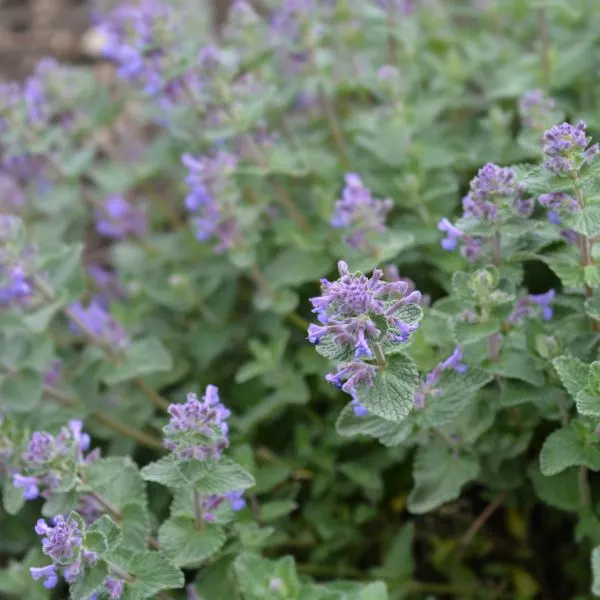
Known by other names like catmint, catnip, catswort, and catwort, catnip is a species of flowering plant in the family Lamiaceae, the mint family.
It is used to make tea and for cats, which have a hyperactive reaction to it.
Catnip is another good companion plant for rhubarb. A slight inconvenience may be due to catnip’s drought tolerance.
This plant does not require a lot of moisture as opposed to the other party, rhubarb, which appreciates water.
However, a little spacing can help with this problem.
Catnip can also take some more water as long as its soil is lightly moist and not soggy.
Like rhubarb, catnip is an aromatic plant and this combo is great for repelling pests.
Some insect pests like aphids, beetles, cabbage worms, mosquitoes, and rodents like mice can be kept from your garden when rhubarb and catnip are planted side by side.
With this, pollinators like butterflies are attracted too.
The whole idea of companion planting is to grow your plants comfortably and possibly increase yield.
These objectives are achieved by pairing catnip and rhubarb.
Pests are kept away, beneficial insects are attracted; this makes for a better harvest.
7. Cauliflower
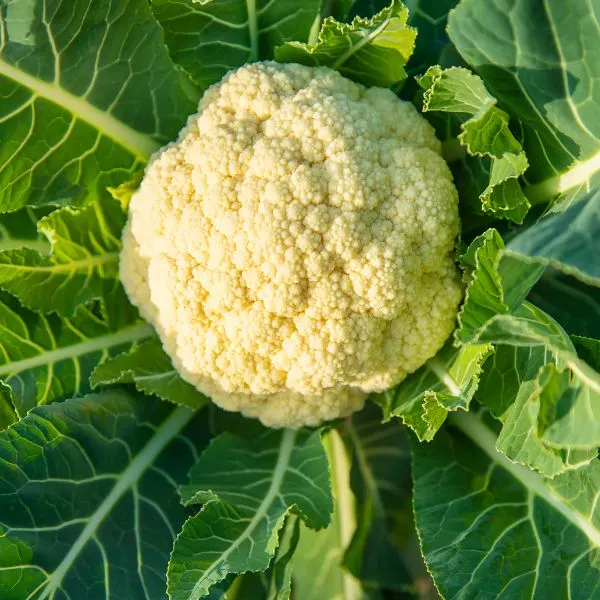
Cauliflower is another flowering plant in the Brassicaceae family, cultivated for its partially developed flowers, referred to as the head or “curd”.
The head is edible and mostly in the colors white, yellow, green, orange, brown, or purple.
Just as other brassicas like broccoli and cabbage naturally go well with rhubarb in the garden bed, cauliflower also makes a great companion for rhubarb. It can help with some amount of pest control while serving as ground cover.
Although inconsistently, some brassicas like cauliflower are known to release chemical compounds, called biotoxins, that may be toxic to some soil-borne pathogens and pests.
This includes nematodes, fungi, and some weeds.
This will help prevent attacks from some pests attracted to rhubarb. In addition to pest control, they help to control erosion by providing good ground cover and are able to scavenge for nutrients, capturing nitrogen in the soil.
Rhubarb also benefits cauliflower. Because of its height, it can provide shade to cauliflower plants and prevent their risk of being damaged by the sun.
This provision of shade preserves the health of your plant.
Cauliflower and other brassicas tend to suffer attacks from whiteflies.
Rhubarb has a strong scent and poisonous leaves that these pests do not like.
Planting rhubarb with cauliflower can help with the control of whitefly infestation.
8. Chamomile
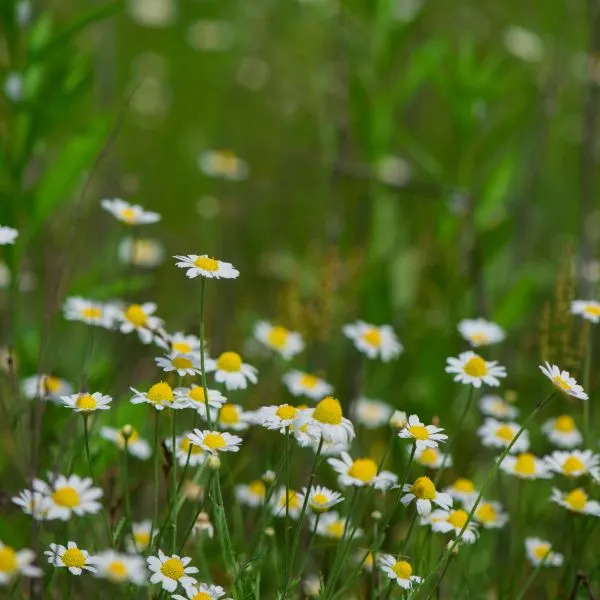
With an alternative spelling “camomile”, chamomile is a flowering plant of the daisy family Asteraceae.
It has feathery leaves and flowers with white rays.
Parts of this apple-scented plant are made into healthy beverages high in antioxidants.
Chamomile is an excellent herb to plant beside your rhubarb, although they have slightly different requirements for their growth.
Both plants like full exposure to sunlight but the herb is drought tolerant, preferring drier soil than rhubarb.
The joint presence of rhubarbs and chamomiles in the garden helps control pests and attract beneficial insects.
Chamomile repels flying insects like mosquitoes. This repellent quality combined with that of rhubarb is able to keep insects away.
This herb also brings beneficial insects to the crops in your garden.
The beautiful flowers of chamomile plants attract flower flies to aid pest control and other insects that aid in pollination.
Beneficial wasps, honey bees, hoverflies, and ladybugs are some insects that chamomile can attract.
Rhubarb and chamomile are very good companion plants for each other, with the ability to deter several pests from your other plants.
9. Chives

A chive is a flowering plant that produces edible leaves and flowers, an allium like onions or shallots.
It is used as a seasoning in food, with its flavors of onion and garlic.
Alliums like chives need lots of water for optimal growth.
Rhubarbs and chives thrive in similar conditions.
They both love exposure to full sun, well-draining soil rich in organic matter, and consistent moisture.
Plants like these that like to be grown in the same environment tend to do well as companions.
Other flowering plants like chives are beneficial beside your rhubarb because they are attractive and produce nectar.
This means that they are able to attract pollinators like bees and butterflies to the rhubarb beside them.
Because they are aromatic plants, they are naturally repellent to some insect pests like aphids, leaf beetles, and weevils.
In keeping these destructive insects away, your rhubarb is kept healthy.
Chives also add to the taste of rhubarbs.
Through this companionship, the yield of rhubarbs is positively affected.
Because they attract pollinators, repel pests and help improve taste, chives provide many benefits to rhubarb plants when they are grown side by side.
10. Columbines

This is a genus, Aquilegia, of about 60 to 70 species of perennial flowering plants found in meadows, woodlands and at higher altitudes throughout the Northern Hemisphere.
They are known for their flowers which have spurred petals.
Rhubarbs and columbines do not have exact requirements for optimal growth.
While both plants like evenly moist, well-draining soil, columbines would rather have partial shade than full sun, especially in warmer climates.
They would tolerate full sun on cooler days, however.
They require average moisture levels, keeping their soil evenly moist but never soggy to reduce the chances of root rot as much as possible.
Do not let them stay wet for long.
Columbines benefit from companionship with rhubarbs.
They are easily susceptible to attacks from spider mites, pests that can be put off by the smell of rhubarbs. Having a rhubarb plant nearby helps to repel such insects.
To return the favor, the lacy flowers of columbine plants draw several beneficial insects to your rhubarb and the garden as a whole.
They attract insects such as bees, butterflies, and moths, and other animals like hummingbirds.
The delicate-looking but resilient columbine is one more crop to consider planting near rhubarb.
The latter can contribute to the control of pests that the former is easily attacked by.
In return, columbines bring helpful insects to rhubarbs.
11. Dill
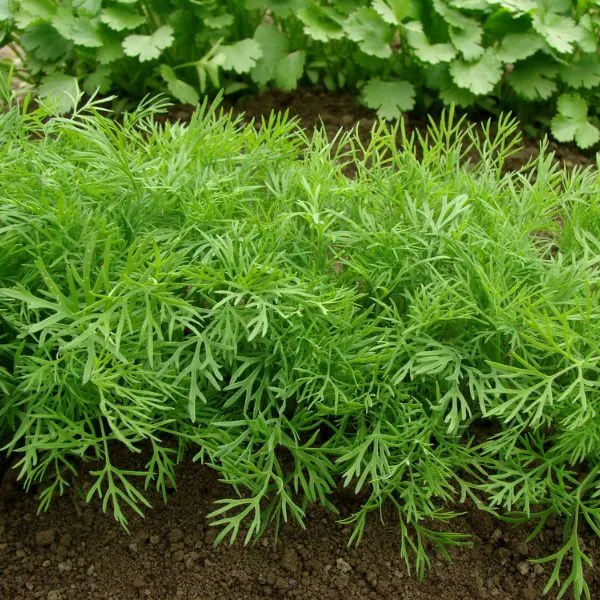
Another good companion plant for rhubarb is dill.
Dill is an annual herb in the celery family cultivated for its leaves and seeds, which may then be used as herbs or as a seasoning for food.
Dill is widely grown in Europe and Asia.
This herb fosters the growth of rhubarb plants.
This is a result of the long or deep taproots that dill has that break up heavy soils and loosen the soil.
This reduces the chances of weeds growing and helps the roots of rhubarb plants spread.
Dill can help reduce the infestation of pests like aphids that like to chew on the large leaves of rhubarb plants.
Aphids tend to dislike strong-smelling plants like herbs and alliums.
When it has produced flowers, dill is even more beneficial.
The flowers of the plant attract several beneficial insects to your plant, including pollinators and predators of pests.
Bees and butterflies are some insects that aid pollination which dill attracts to your garden.
Rhubarb’s health is also improved by dill’s ability to attract predators of the pests of rhubarb plants, such as hoverflies and ladybugs that eat aphids, and wasps that lay eggs to destroy aphids and caterpillars.
Furthermore, rhubarb and dill have corresponding soil and care requirements.
They both need direct exposure to the sun and consistent watering to maximize their potential.
They like to be grown in rich, moist but well-draining soil.
12. Garlic

Garlic is a flowering plant in the genus Allium, just like chives, leeks, onions, shallots, and some other aromatic plants.
It has a pungent bulb divided into cloves which are used to season food or make an oil sprayed to deter pests.
Garlic is a very good companion plant to rhubarb as it can provide several advantages to the plants near it in the garden.
Sulfur is a substance that can help to protect crops from several fungal diseases.
By emitting this fungicide, sulfur, garlic improves the health of your rhubarb plants and shields them from fungal diseases.
Garlic is also naturally pest-repellent because of its very strong scent that many pests of rhubarb do not like.
The scent is able to keep aphids, ants, leaf beetles, weevils, whiteflies, and many other bugs away from your rhubarb, protecting it from the destruction of its leaves and stalks.
The scent of garlic can also deter rabbits.
Planting rhubarb with garlic is a great idea.
Although one cannot expect that all the pest problems of the rhubarb in one’s garden would be solved by the presence of garlic, this allium can benefit and improve the growth of rhubarb.
13. Kale

Another good companion for rhubarb belonging to the family Brassicaceae is kale.
Kale, also called leaf cabbage, is a flowering plant with edible green or purple leaves that do not form a central head.
Its leaves may be eaten or used for ornamental purposes.
Kale and rhubarb naturally go well beside each other in the garden.
They benefit each other, with kale aiding providing ground cover, and aiding pest control.
Rhubarb in turn shades kale and protects it from whitefly infestation.
Brassicas release some amounts of biotoxins, which are chemical compounds that may be toxic to several pathogens and pests that live in the soil.
This means that kale can help protect rhubarb from fungi, nematodes, and some weeds.
Erosion and the presence of weeds are some consequences of having open, bare soil in your garden.
These problems can be solved or at least curbed by the good ground cover that kale provides when planted near rhubarb.
Kale can capture nitrogen remaining in the soil after harvest, and this nutrient is very important for rhubarb’s development.
Towering over kale, rhubarb shades it to preserve it from the damage that may result from its overexposure to sunlight.
Whiteflies are harmful to kale and other brassicas.
The strong scent of oxalic acid present in rhubarb deter these pests. Rhubarb is able to control whitefly infestation, benefiting the brassicas too.
14. Kohlrabi

Kohlrabi is a cultivar of wild cabbage, also known as a German turnip. This vegetable has edible leafy greens, thin stems, and yellow flowers.
It is nearly spherical in shape with more flesh than skin and tastes like cabbage.
This is another brassica that provides good companionship for rhubarb.
Like others, rhubarb provides shade for this plant to protect it from sun damage.
With its strong scent and poisonous leaves, rhubarb can deter whiteflies.
Brassicas like kale provide good ground cover for rhubarb, reducing the chances of erosion and weed growth.
They aid pest and disease control by releasing biotoxins into the soil. They are also able to capture nitrogen to benefit rhubarb.
15. Marigolds

Marigold is a herbaceous flowering plant with green, pinnate leaves and brightly colored flowers.
These attractive flowers are most popularly yellow but they may come in other colors like white, yellow, orange, or golden.
Like rhubarbs, marigolds have a repellent effect on several crop pests.
When both of them are planted side by side, they are able to keep aphids, beetles, cabbage worms, mice, mosquitoes, nematodes, squash bugs, and whiteflies away.
Such companionship can help reduce the infestation of pests and the spread of diseases among the plants in your garden.
The attractive flowers of marigold plants are also able to attract pollinators and other useful insects to your rhubarb.
These other useful insects are predators of many pests that attack garden crops.
Planting marigolds near rhubarb plants can aid their growth by making the leaves less susceptible to diseases and the attacks of pests.
16. Mint
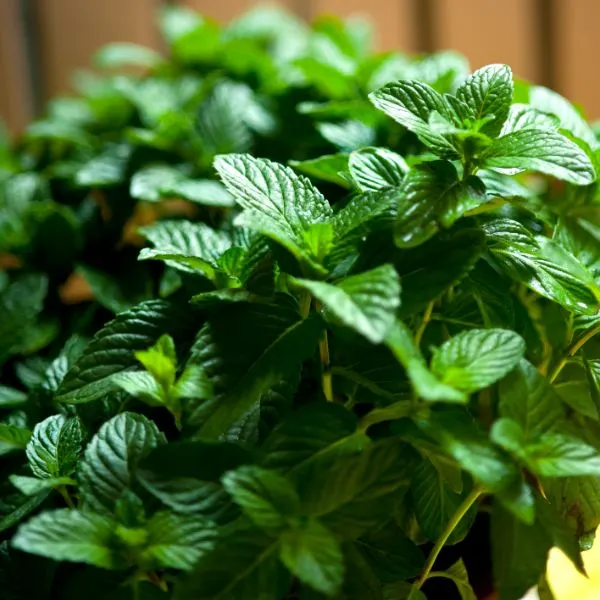
Mint is a genus of about sixty aromatic herbaceous flowering plants in the biological family Lamiaceae.
Most plants in this genus are perennial, with several species, cultivars, and hybrids, like peppermint, which is really good for rhubarb.
Growing rhubarb with mint goes a long way in deterring many pests of the plants in the area.
They both have very strong scents to keep common pests away from your garden, especially from nearby plants.
Peppermint specifically deters aphids, cabbage moths, and flea beetles.
Peppermint is one of the best varieties of mint for repelling pests. This herb does not only keep harmful insects away, but it also draws beneficial ones towards it.
Because mint is a notoriously invasive genus no matter what species, hybrid or cultivar, it is best to control it.
This is done by planting the mint in its own separate pot or vessel.
By doing so, its fast-growing horizontal roots do not compete with and dominate the rhubarb next to it.
17. Nasturtiums

Also known as tropaeolum, nasturtium is a genus of plants that contains several annual or perennial creeping herbs.
These have showy round flowers which may be used to make herbal medicine or for culinary purposes.
Nasturtiums are also good companion plants for rhubarb.
A minor issue may be their drought tolerance, as they would rather have moderate amounts of water than too much.
This aside, they like full sun and rich, well-drained soil just like rhubarb.
They can serve as ground cover in the garden, maximizing your space.
This helps curb erosion and discourage weeds from growing around your rhubarb to compete for nutrients.
Nasturtiums can also deter specific pests.
Because of their strong scents, pairing these flowers with rhubarb can serve the purpose of pest control for rhubarb plants and other crops around this pair.
Nasturtium repels aphids, beetles, cabbage moths, squash bugs, and whiteflies.
Apart from helping rhubarb plants fight pests, nasturtiums also have very beautiful and conspicuous flowers with which they are able to attract beneficial insects to the rhubarb in the garden when they grow side by side.
18. Onions

An onion is a flowering plant in the genus Allium with bluish-green leaves and a bulb at its base.
This bulb is made up of shortened underground stems and fleshy modified leaves.
Onion is the most widely cultivated vegetable in its genus.
Onions and rhubarbs thrive in similar environments.
They both need direct exposure to full sunlight, lots of moisture, and rich, well-draining soil.
Onions have shallow roots that do not compete for nutrients with rhubarb’s deep taproots.
They are also able to deter several pests, including some that rhubarb is susceptible to and some that attack other plants around them but they are easily attacked by onion flies.
The scent of rhubarbs can confuse the flies.
Onions can keep aphids, Japanese beetles, leaf beetles, rabbits, weevils, and whiteflies away from rhubarbs and other plants.
They have natural fungicidal properties that can help protect your rhubarb from several fungal diseases.
They have the ability to break up tough clumps of soil and give rhubarb roots space to grow in the deeper layers of the earth.
It is also believed that the presence of onions improves the taste of rhubarb plants when they are grown side by side.
Because they are much taller, rhubarbs provide light shade for onions.
They help shield them from any damage that too much exposure to sunlight may cause.
Both parties benefit from this companionship although rhubarbs benefit more.
19. Raspberries
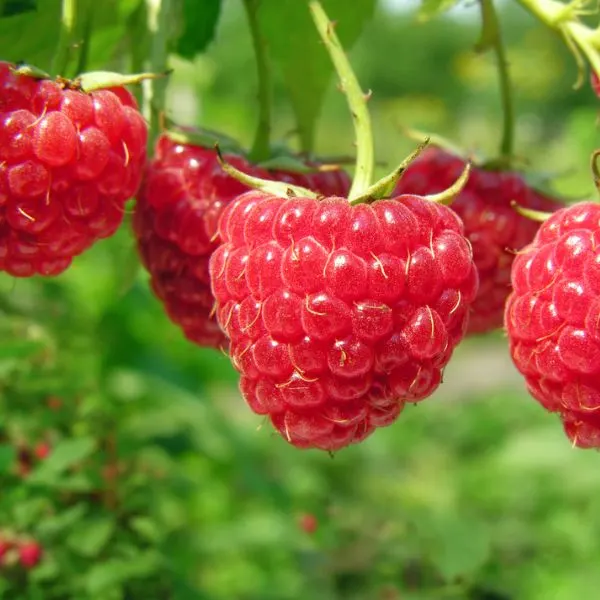
Raspberries are many species of plants in the genus Rubus of the rose family.
They are perennial plants with woody stems that produce edible fruits, also called raspberries.
They are good companions of rhubarb plants.
Rhubarb and raspberry plants seem to grow well together, for reasons that may not be very clear.
It is clear that both plants have similar growth and care requirements but they do not necessarily benefit each other.
Both crops like to spend time in direct sunlight.
They also like rich, well-drained soils.
The only slight difference is that while rhubarbs like consistently moist soil that is wet but not soggy, raspberries like soil that is neither wet nor dry but moderately moist.
Not too many pests attack raspberries but some that do are Japanese beetles, raspberry cane borers, raspberry sawflies, rose stem girdlers, spider mites, and spotted wing drosophila.
Rhubarbs can keep some away with their strong scent.
20. Roses

Woody roses flowering plants in the biological family Rosaceae.
These biennial or short-lived perennial plants have distinct flowers which are popular for decoration.
The different species or cultivars of roses have peculiar colors.
Rhubarbs and roses are comfortable growing together because they have similar requirements and care needs.
Both plants appreciate full or direct exposure to sunlight.
Both roses’ shallow and rhubarbs’ deep roots thrive in moist soil.
Besides their compatibility, rhubarbs can preserve roses by repelling pests that are easily attracted to them.
Some of these are ants, aphids, and mealybugs.
Cultivating rhubarbs near roses reduces the chance of the roses being destroyed.
The beautiful flowers also attract pollinators, mostly bees and butterflies, to rhubarbs and other plants in the garden.
This companionship has benefits for both parties: protection from pests and attraction of beneficial insects.
21. Sage

Sage is a herbaceous flowering plant that belongs to the mint family Lamiaceae.
It has distinct grayish-green leaves, bright purple flowers, and a strong odor.
Although sage needs less water than rhubarbs, they can be grown together.
Adequate spacing should however be considered when these two plants are cultivated together.
Sage appreciates direct or indirect exposure to the sunlight, with moist but well-drained soil and moderate amounts of moisture for optimal growth.
Sage has the ability to attract predatory insects to feed on as many pests as possible nearby bugs while harming neither the sage nor your rhubarb plants.
Its flowers also attract bees and butterflies, pollinating insects, to your garden.
The deep roots of rhubarbs need space to grow in the deeper layers of the soil.
Sage can help them access this much-needed space by breaking up tough soil clumps and aerating these deeper layers for rhubarb’s benefit.
22. Strawberries

Strawberries are good companion plants for rhubarbs in the garden.
They are low perennial herbs with many runners and white flowers.
They produce edible fruits that are small achenes scattered on the surface of an expanded red pulpy berry.
These plants grow low and do not get in the way of rhubarb.
Rhubarbs shade them and protect them from damage from the sun. They are able to act as ground cover for rhubarb, reducing the activity of weeds and preserving soil moisture.
Because rhubarbs have long taproots, they need space in the soil to grow and expand.
Strawberries have deep roots that break up clumps of soil, creating this space for rhubarb roots and helping to suppress weeds.
Rhubarb’s dark green leaves and red stalks look attractive when planted with the flowers of strawberry plants. They go well together naturally.
Harvesting is also made easier as both of them tend to ripen around the same time.
Slugs and some other pests are known to be very attracted to strawberries, eating away at their leaves and impairing their health. Because of the strong scent that rhubarb has, it may keep some of these pests away.
The scent of rhubarb masks the smell of strawberries and in doing so protects them from pests that find their food by smell.
Strawberries are also said to enhance the flavor and taste of rosemary when they are planted together.
23. Thyme
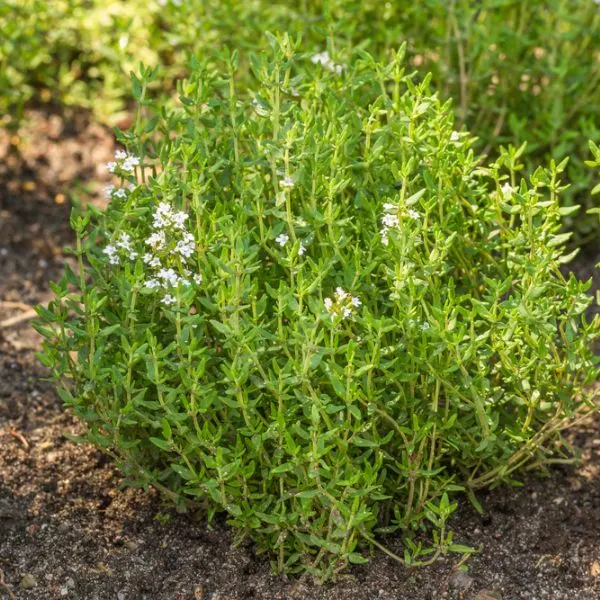
Thyme is an aromatic evergreen herbaceous plant in the mint family Lamiaceae.
It is a perennial flowering plant closely related to mint, oregano, and sage. It is yet another herb that grows well near rhubarb, a good companion plant for it.
Despite thyme’s drought tolerance, it grows well beside rhubarb. You should be careful with this pairing, however.
This is because if the adequate spacing is not given between the two, only one would thrive while the other dies.
This companionship brings advantages to both parties.
Thyme can act as a repellent for various insect and animal pests that attack garden crops. This benefits rhubarbs and other plants nearby.
Cabbage worms, corn earworms, tomato hornworms, and whiteflies are some of the pests that thyme repels.
This plant not only keeps pests away; it is able to attract beneficial ones like pollinators to the area.
Planting thyme next to rhubarb will also help prevent any root rot in their wet soil. Root rot is caused by a fungus in the soil.
Thyme has antifungal properties, as it contains thymol and carvacrol which make it suitable for preventing this fungal disease.
24. Turnips

A turnip or white turnip is a flowering plant in the cabbage family Brassicaceae.
This root vegetable is commonly grown in temperate climates worldwide for its edible, white, and fleshy taproot which may be eaten raw or cooked.
Turnips grow much taller than rhubarbs so they do not serve as ground cover. However, they are able to keep some pests away from your garden and control some diseases by releasing biotoxins into the soil.
Biotoxins are chemical compounds that are toxic to some soil-borne pathogens and pests.
They are also able to capture nitrogen remaining in the soil after harvest to benefit rhubarb.
Rhubarb, to reciprocate, deters whiteflies which are notorious pests of brassicas.
8 Bad Companion Plants for Rhubarb
1. Black Walnuts
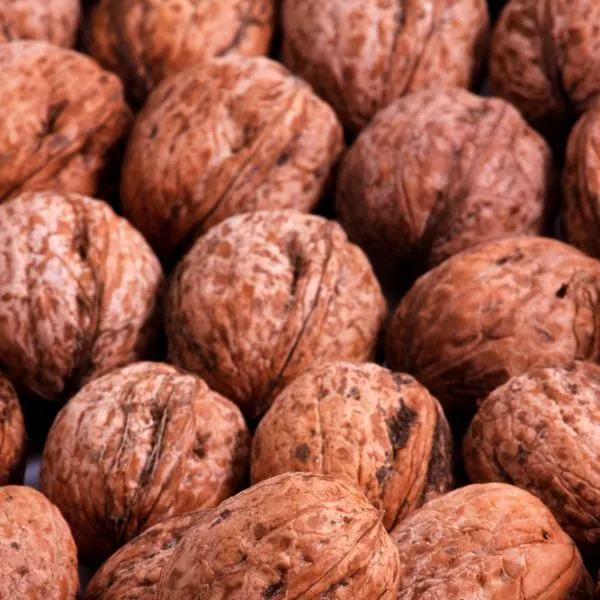
Also known as the eastern American black walnut (because it is native to the riparian zones of North America), the black walnut is a species of deciduous tree in the walnut family.
It is grown for its distinctive, alluring taste, and used for both timber and food.
It is not ideal to grow black walnut trees with rhubarb plants.
Although they both like full exposure to the sun, moist but well-drained soil, and consistent watering, they are not to be planted side by side.
This is because of the chemical that black walnut released into the soil. The compound, called juglone, can prevent rhubarbs from reaching their full potential.
It may slow their growth down or stop it entirely.
2. Blueberries

Belonging to the same genus as bilberries and cranberries, blueberries are perennial flowering plants that produce edible blue or purple berries.
They are bad companion plants for rhubarb.
Rhubarb requires slightly alkaline soil to develop properly but the ideal soil for blueberries is acidic.
Planting these two together means that one will not thrive and may not even be able to survive the growing conditions of the other.
Another reason why this pairing is very problematic is that rhubarb is a heavy feeder.
Because it uses up a lot of extra soil nutrients, it needs very rich soil augmented with compost or fertilizers.
On the other hand, blueberries are very sensitive to fertilizer, preferring organic matter and moderate amounts of compost.
If you are growing half-high blueberries, rhubarbs can grow a lot taller and shade them too much from adequate sunlight.
3. Cucumbers
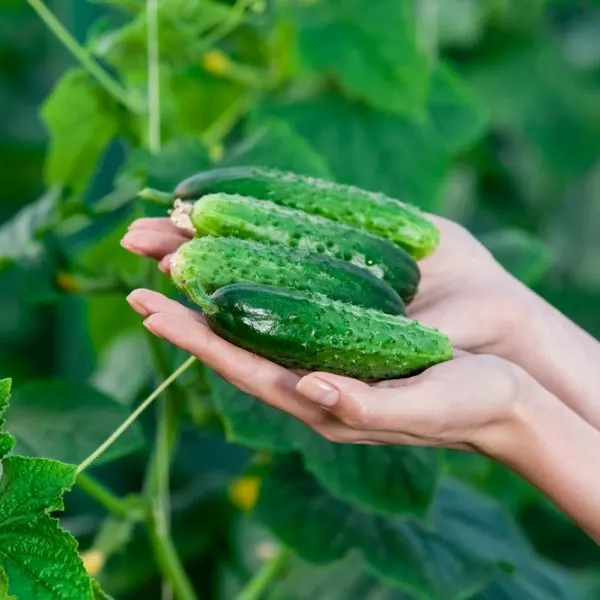
Another bad companion plant for rhubarb is the cucumber.
The cucumber is a creeping vine plant considered an annual crop.
The plant produces mostly cylindrical green fruits used in cooking as vegetables, usually eaten raw or pickled.
They also have similar growth needs to those of rhubarb plants. Cucumbers can tolerate partial or full shade but they prefer exposure to direct sunlight for six to eight hours daily.
They like lots of moisture and should be watered regularly.
All this aside, cucumbers compete with your rhubarb for soil nutrients and sunlight.
Like rhubarbs, they are heavy feeders and end up taking up the nutrients, nitrogen, for example, that rhubarb needs.
In addition to taking nutrients away from the soil, cucumbers strive for sunlight.
Regardless of the plant beside them, they are so competitive that they make sure they get enough light and nutrients.
Cultivating rhubarb beside such a competitive plant when the crop itself is a heavy feeder evidently does not produce great results.
The rhubarb may not survive this competition, leading to malnourishment and consequently, poor yield.
4. Dock

Docks are annual, biennial, or perennial herbs in the family Polygonaceae, the buckwheat family.
They are very common flowering and aromatic plants, natively distributed almost worldwide.
Some dock plants are grown for edible leaves.
Plants in this genus also need what rhubarb needs: full sun, moist but well-drained soil, and enough water. Nonetheless, they should not be planted with rhubarb.
Dock tends to be invasive and may be treated as a weed in the garden.
Curculios or snout beetles are attracted to this plant like they are to rhubarb.
When they are grown in close proximity, the health of rhubarb is endangered because the same pest can damage your rhubarb’s stalks, negatively affecting the plant.
5. Melons
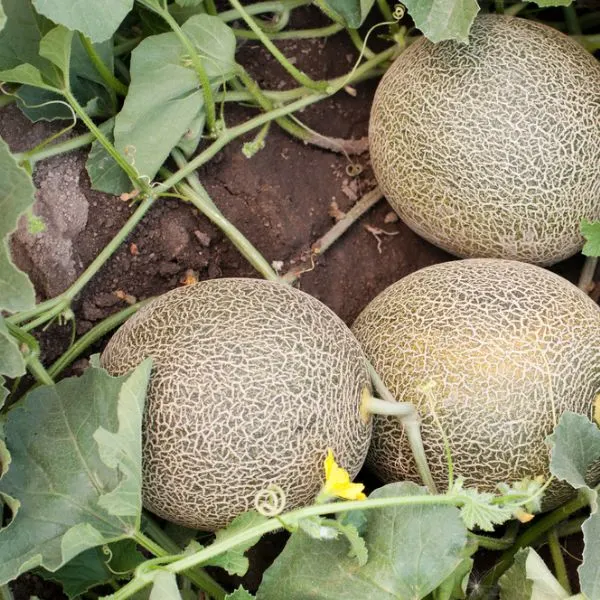
Melons are the various plants of the family Cucurbitaceae, the gourd family to which cucumbers belong.
These flowering plants produce sweet, edible, and fleshy fruit. Both the plants and their fruits are referred to as melons.
Despite needing the same growing conditions as rhubarbs, melons should not be cultivated near these crops.
Melon leaves can act as good ground cover in your garden but they should be kept away from rhubarbs.
This is because they can also compete with your rhubarb for sunlight. They require lots of sunlight to grow. If the amount of sunlight they are receiving is inadequate, they exhibit positive phototropism, growing towards the sunlight.
While vining upwards, the vines of melons will grow over the rhubarb in their way, wrapping around it and spreading their leaves above it.
This competition deprives rhubarb of adequate sunlight for growth, leading to stunted growth.
6. Pumpkins
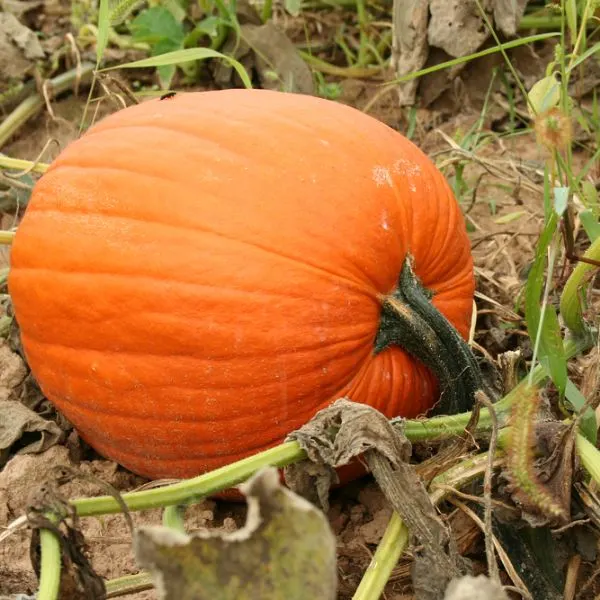
The pumpkin is a coarse vining plant widely cultivated for the fruit it produces.
This pumpkin fruit is a large pulpy round fruit with firm orange skin and numerous seeds. This plant is also in the gourd family Cucurbitaceae, a relative of melons.
Like melon, pumpkin is a bad companion plant for rhubarb. It competes with your plant for sunlight. It also shows positive phototropism when receiving inadequate sunlight, growing towards the sun, and likely depriving rhubarb of this sunlight.
7. Sunflowers
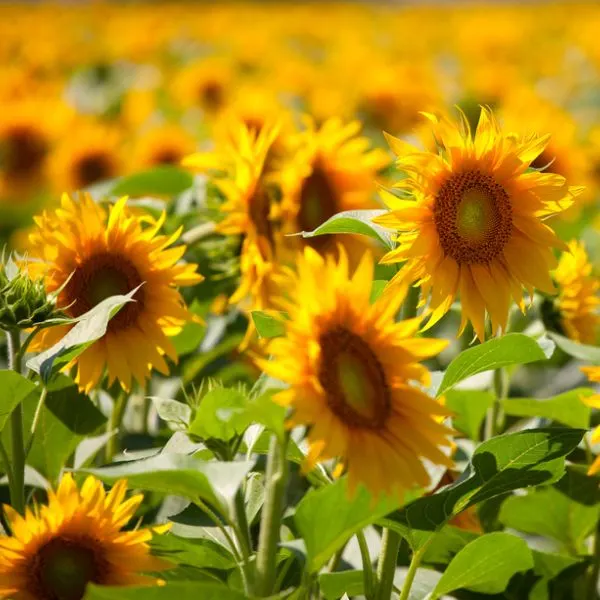
A sunflower is any species of annual and perennial plants that belong to the genus Helianthus in the family Asteraceae, the daisy family.
They bear flowers that have large heads, dark disk florets, and flamboyant yellow rays.
Do not plant sunflowers beside rhubarbs.
Although both plants like growing in full sun, their moisture needs are quite different.
Sunflowers prefer dry soil over wet soil although they tolerate moisture if the soil drains well.
In spite of the compatibility, sunflowers are susceptible to attacks from boring weevils, and curculios. Rhubarbs are also attacked by rhubarb curculios which bore holes into the leaves and stalks of rhubarb plants.
If these two plants are grown together, these pests will be drawn to that area of your garden. This impairs the health of both plants and is worse if thistles are around the area.
Plant sunflowers with other crops that can help control the infestation of snout beetles.
8. Tomatoes

Tomatoes are South American plants of the nightshade family Solanum.
They produce a widely grown mildly acidic fruit also known as tomato, with many varieties.
Tomatoes are a glossy red or yellow color, pulpy and edible, eaten raw or cooked.
Just like sunflowers, tomatoes tend to attract several pests that rhubarb also suffers infestation from.
Tomatoes are easily susceptible to attacks from many pests, so planting them beside rhubarbs can lead to much more problems.
Some such pests include aphids, budworms, cutworms, flea beetles, looper caterpillars, nematodes, red spider mites, slugs, thrips, tobacco hornworms, tomato fruit worms, tomato hornworms, and whiteflies.
Of these examples, rhubarbs also attract aphids, caterpillars, flea beetles, and slugs.
Tomato’s presence can compound the pest problems other good companion plants try to help solve. It can also bring other pests to other plants around the area.
FAQs
What can I plant next to the rhubarb?

Some crops that you can plant next to rhubarb are asparagus, beans, beets, broccoli, cabbage, catnip, cauliflower, chamomile, chives, columbines, dill, garlic, kale, kohlrabi, marigolds, mint, nasturtiums, onions, raspberries, roses, sage, strawberries, thyme, and turnips.
What should not be planted near rhubarb?

Crops that should not be planted near rhubarb include black walnuts, blueberries, cucumbers, dock, melons, pumpkins, sunflowers, and tomatoes.
What flowers can you plant next to rhubarb?

Some flowers that you can plant next to rhubarb are chamomile, columbines, marigolds, nasturtiums, and roses.
Can you plant tomatoes close to rhubarb?

It is not advisable to plant tomatoes close to rhubarb as they are bad companion plants for your vegetable.
They attract too many pests that could also attack your rhubarb. Growing them together brings the disadvantage of increased pest infestation to your rhubarb plants.
Aphids, caterpillars, flea beetles, and slugs may be more attracted to that section of your garden if both rhubarbs and tomatoes are planted there
Does rhubarb like sun or shade?

Rhubarb likes to be grown in full sun, with an average of eight hours of exposure to direct sunlight.
What to Grow or Not with Rhubarb
Quick points:
- Rhubarb & strawberries both enjoy a straw mulch
- Brassicas protects from many insects
- Combine rhubarb with beans helps to deter aphids
- Growing onions, garlic, and columbines with rhubarb will deter pests
- What not to grow with rhubarb: dock, thistles, and sunflowers because they attract the rhubarb curculio
- Home-made insect repellent spray
- Roses & brassica keep away whiteflies
- Don’t forget rhubarb leaves are poisonous
Video – Top 8 Rhubarb Companions
Conclusion
Rhubarb is a fairly easy plant to grow and take care of. While considering what to plant with this vegetable, take into account the fact that it grows quite tall and might shade some shorter crops too much from the sun.
Above are twenty-four (24) plants you can grow alongside rhubarb in your garden and eight (8) plants to avoid growing beside it.
The plants are briefly explained and reasons, why they are good or bad companion plants, are then given.
This vegetable grows for a long time, is not attacked by too many pests, and is quite easy to grow. Its stalks or stems are used all year long to make several desserts and sauces, adding its tart and tangy flavor.
It is best cultivated in late fall or early spring alongside good companion plants and with adequate care practices.
As a perennial plant, rhubarb yields harvest after the first year and for up to eight years.
For maximum results, plant your rhubarb in a bright area where it can get full, uninterrupted exposure to sunlight. It needs an adequate spacing of about 4 to 6 feet apart to allow it to grow and its roots spread.
As previously stated, rhubarb is a heavy feeder, needing lots of nutrients.
To keep up with this, mix organic material like aged compost into the soil to make it richer.
Regularly check soil moisture and water the plant if the top soil feels dry.
Check out more types of things
